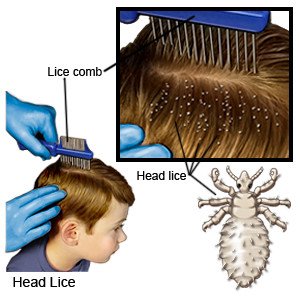Head Lice in Children
Medically reviewed by Drugs.com. Last updated on Apr 6, 2025.
What do I need to know about head lice?
- Head lice are tiny bugs that attach to your child's hair. They live on tiny amounts of blood from your child's scalp. They are about the size of a sesame seed. They lay eggs (nits) and attach the eggs to your child's hair. Anyone can get head lice, but it is most common in preschool and elementary school aged children.
- Head lice cannot jump, fly, or hop. They crawl and are spread through close, extended head-to-head direct contact. Some examples are children taking a nap close together, or sharing combs, hats, pillows, or towels.
What are the signs and symptoms of head lice?
Your child will not feel the bites. He or she may have any of the following:
- Severe itching on the scalp, neck, or ears that may be worse at night
- Nits (tiny ovals that are grey, yellow, or white)
- Tan or reddish-brown bugs in your child's hair
- Small red bumps or a rash on your child's scalp
- Swollen lymph glands in your child's neck
How are head lice diagnosed?
Your child's healthcare provider will examine your child's scalp and hair. He or she may use a fine-tooth comb to collect the lice and examine them with a microscope.
How are head lice treated?
Check with your child's healthcare provider before you begin lice medicine. Lice medicine is used to kill head lice and usually comes as a shampoo. You can buy it at your local pharmacy or drugstore. Follow these safety guidelines when you use the lice medicine:
- Lice medicine should be applied by an adult. Use it as directed.
- Do not use it on a child 2 years or younger without checking with his or her healthcare provider.
- Do not apply lice medicine on your child if you are pregnant or breastfeeding without checking with your healthcare provider.
- Place your child's head over a sink and rinse with warm water. Do not get the medicine in the his or her eyes.
- Do not rinse in a shower or bath. The lice medicine should not run off your child's head onto other parts of his or her body.
- Do not leave a child alone with the lice medicine on his or her head.
- Throw away all lice medicine that you do not use.
Treatment options
The following list of medications are related to or used in the treatment of this condition.
How can I manage my child's head lice?
- Comb your child's wet hair with a fine-tooth comb. Wet combing and lice medicine are the most effective way to treat lice. Comb your child's wet hair every 2 or 3 days for 2 to 3 weeks to remove all nits and eggs.
- Wet your child's hair.
- Comb through your child's wet hair in small sections with a fine-tooth comb.
- Remember to wipe the comb on a wet paper towel after each comb-through.
- Repeat until you have combed through all of his or her hair.

- Remind your child not to scratch his or her scalp. This can make his or her symptoms worse. Trim your child's fingernails or have him or her wear soft gloves or mittens if scratching is a problem.
- Do not shave your child's hair. Do not use pet products, acetone, bleach, kerosene, or other flammable products to kill lice. Household products such as oils, margarine, mayonnaise, and petroleum jelly do not work.
How can I prevent the spread of head lice?
- Check household members for lice. Treat household members with lice in the same way as your child.
- Wash all clothes, stuffed animals, towels, and bedding in hot, soapy water. Dry them on the hot cycle for at least 20 minutes. Items that cannot be washed or dry cleaned should be sealed in an airtight plastic bag for 2 weeks. Vacuum furniture, rugs, carpets, car seats, or other fabrics.
- Disinfect personal items. Soak combs and brushes in hot water for 5 to 10 minutes. After each treatment, wash the lice comb and clothing your child wore during the treatment.
- Tell your child's school or daycare center. Children who may have been exposed to lice need to be screened and treated. Your child can return to school after he or she has used lice medicine.
When should I call my child's doctor?
- It has been 7 days of treatment and you think you need to repeat lice medicine.
- Your child has a fever.
- Your child's bites become filled with pus or are crusty.
- Your child's scalp burns, stings, or is numb after using the lice medicine.
- You have questions or concerns about your child's condition or care.
Care Agreement
You have the right to help plan your child's care. Learn about your child's health condition and how it may be treated. Discuss treatment options with your child's healthcare providers to decide what care you want for your child. The above information is an educational aid only. It is not intended as medical advice for individual conditions or treatments. Talk to your doctor, nurse or pharmacist before following any medical regimen to see if it is safe and effective for you.© Copyright Merative 2025 Information is for End User's use only and may not be sold, redistributed or otherwise used for commercial purposes.
Learn more about Head Lice
Treatment options
Symptoms and treatments
Further information
Always consult your healthcare provider to ensure the information displayed on this page applies to your personal circumstances.
